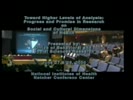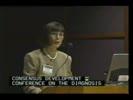| Description: |
BACKGROUND: Though mortality from breast cancer on the whole has declined over the past 15 years, the risk of African-American women dying from the disease is 37 percent higher than that of white women. Previous explanations have
considered the role of environmental (social and ecological) and genetic
factors separately. However, because 70-80 percent of breast cancers are due
to sporadic rather than hereditary mutations, it is important to understand the
social and ecological factors that influence sporadic mutations. The current
research conducted at the Center for Interdisciplinary Health Disparities
Research (CIHDR) explores the connection between genes and environment by
utilizing a downward causal model developed by the transdisciplinary research
team in which social environmental factors ultimately impact genetic expression
of breast cancer through psychosocial factors such as social isolation,
depression, and acquired vigilance, and biological processes.
METHOD: The team uses animal models and interviews with newly-diagnosed African-American women of a variety of socioeconomic backgrounds in a
mutually-informative, multi-modal approach to understanding the influences of
the social environment on biology, In-home interviews were conducted with the
women newly diagnosed with breast cancer. As a means to explore the impact of
the social environment in disrupting stress responses, saliva samples were
collected four times per day for three days following the interview. Breast
tumor tissue was collected at the time of surgery. In addition, researchers map
the social ecology of the four-block area around each participant’s home,
noting features known to inhibit or encourage social interaction, including
vacant buildings and lots (and their use), the amount of foot traffic, and
location of key services in relation to the participant’s home. Geo-coded data
from the public domain will allow us to measure crime, population density,
housing quality, and other features of the participants’ neighborhoods.
Relationships among the geo-coded public data, observer collected neighborhood
variables, psychosocial data collected from interviews, and biological specimens were analyzed.
RESULTS: Women in the study exhibited high rates of felt loneliness and higher
rates of sexual assault than previously reported for African-American women.
Women also exhibited high rates of depression compared to those in prior
studies of women with invasive breast cancer. We found that felt loneliness,
depression, and sexual assault were strongly correlated with one another and
seem to form a “psychosocial suite” of social and traumatic variables that
connects the neighborhood- level variables to stress hormone response. Cluster
analysis of the diurnal salivary cortisol data revealed two clusters, one with a flat pattern and a more typical pattern. We were able to predict into which group the women fall, using logistic regression analysis, with number of crimes that occurred that year in a quarter-mile buffer zone constructed around each woman’s home and psychological response as predictors. Additional analyses reveal that nighttime rise in salivary cortisol can be predicted by crimes and depression. In preliminary analyses of constructing and analyzing our final, inclusive multi-level models, we are able to predict hormone receptor status from social and psychological variables. Implications: Preliminary findings from our studies suggest biological processes are impacted by social environmental factors in which felt loneliness and depression may be pathways through which the social environment “gets under the skin.” Identifying the causal chain from the social environment to disease will shed light on the social structural conditions that must be targeted to reduce overall mortality from the disease, as well as the disparate outcomes between African-American and white women.
This lecture is an installment of the Behavioral and Social Sciences Research Lecture Series sponsored by the NIH Office of Behavioral and Social Sciences Research and organized by the NIH Behavioral and Social Sciences Research Coordinating Committee.
The Behavioral and Social Sciences Research Coordinating Committee (BSSR CC), with support from the Office of Behavioral and Social Sciences Research (OBSSR), convenes a series of guest lectures and symposia on selected topics in the behavioral and social sciences. These presentations by prominent behavioral and social scientists provide the NIH community with overviews of current research on topics of scientific and social interest. The lectures and symposia are approximately 50 minutes in length, with additional time for questions and discussion. All seminars are open to NIH staff and to the general public. |










